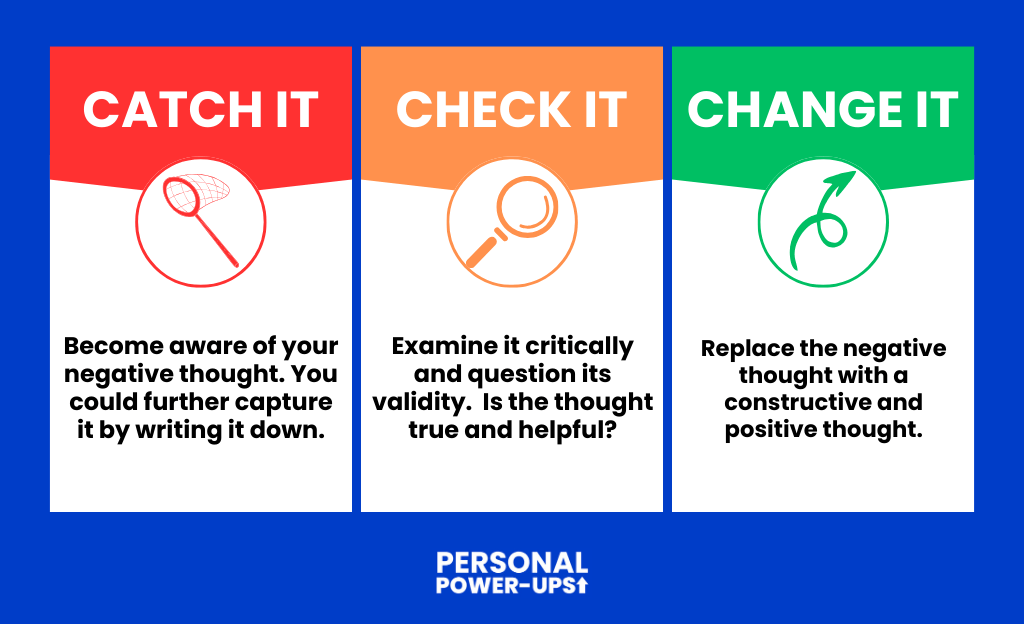Do you ever find yourself caught in a cycle of negative thoughts or behaviors, wondering how to break free from the patterns that hold you back? The solution lies in a simple yet powerful mantra: catch it, check it, change it. In this blog post, we’ll explore the potential of this three-step process, explaining how it can reshape your mindset and lead to lasting positive change.
Contents
What is the Catch It, Check It, Change It Method?
Firstly, let’s break down the three components of catch it, check it, change it. These words summarize a process to interrupt negative thought patterns, examine their validity, and to replace them with constructive and more positive alternatives. It’s rooted in Cognitive Behavioral Therapy (CBT) and is an important way to improve your mental health.
Catch It: Identify Negative Patterns
The first step in the process is to catch the negative thought or behavior as it occurs. Picture this step as shining a spotlight on your thoughts, bringing them into conscious awareness. It’s about becoming a mindful observer of your own thoughts.
Have you ever found yourself ruminating on a mistake, imagining worst-case scenarios, or having negative self-talk? These are precisely the moments when you need to catch those negative thoughts in action. Awareness is the key, and catching these thoughts is the first stride towards positive change.
Check It: Question the Validity
Once you’ve caught the negative thought, the next step is to check it. This involves examining the thought critically and questioning its validity. Ask yourself: Is this thought based on facts? Is it helping or hindering my progress? Checking the negative thought is about introducing a rational perspective into the equation.
For example, if you catch yourself thinking, “I’ll never succeed in this project,” take a moment to check it. Challenge yourself to identify evidence that supports or refutes this belief. More often than not, you’ll find that the negative thought lacks a solid foundation. Checking it helps you differentiate between constructive self-awareness and self-sabotage.
Change It: Transform Negativity into Positivity
Having caught and checked the negative thought, it’s time for the most empowering step – change it. This involves replacing the negative thought with a positive and constructive one. The goal is to shift your mindset from defeatist to empowering, creating a mentality that embraces growth and resilience.
For instance, if your initial thought was, “I’ll never succeed in this project,” change it to, “I may face challenges, but I have the skills and determination to overcome them.” Changing the thought is not about wishful thinking but about cultivating a mindset that supports your goals and aspirations. If you’d like some help with changing negative self-talk into positive self-talk, then be sure to check out our 7 positive self-talk exercises.

Examples of Catch It, Check It, Change It
Understanding the individual components of “Catch it, check it, change it” is crucial, but the real power lies in seamlessly transitioning between these steps. Let’s explore how this process can unfold in real-life scenarios.
Example 1: Overcoming Procrastination
Catch It: You catch yourself procrastinating on a work assignment, avoiding starting the task due to a fear of failure.
Check It: Pause and analyze your feelings. Is the fear of failure a rational reason to procrastinate? Question the validity of this thought and consider whether it’s based on facts or assumptions.
Change It: Replace the negative thought with a positive affirmation. Instead of thinking, “I’ll probably fail anyway,” change it to “I have the skills needed for this task, and taking the first step is the key to success.” Now, approach the task with a more optimistic mindset.
▼ Ad
Example 2: Dealing with Negative Feedback
Catch It: You receive critical feedback at work and immediately feel a surge of defensiveness and self-doubt.
Check It: Take a moment to reflect on the feedback objectively. Is there merit to the criticism, or are you letting emotions cloud your judgment? Question the validity of your initial emotional response.
Change It: Transform your initial negative reaction into a constructive one. Instead of dwelling on perceived shortcomings, acknowledge areas for improvement and view the feedback as an opportunity for professional growth. Change the thought to “I appreciate the feedback as it helps me become better at what I do.” This is one of the differences between a growth and fixed mindset.
Example 3: Resolving Conflict in a Relationship
Catch It: During an argument with your partner, you catch yourself resorting to blame and defensiveness, thinking, “It’s always their fault; they never understand me.”
Check It: Reflect on your emotions and the root causes of the conflict. Are you reacting based on past experiences or projecting unrelated frustrations onto your partner? Consider if there’s a more empathetic and understanding perspective to the situation.
Change It: Shift from a defensive stance to a more empathetic approach. Instead of blaming, express your feelings openly and actively listen to your partner’s perspective. Change the negative thought of “It’s always their fault” to “We both have valid feelings, and we can work together to find a solution.”

Catch It, Check It, Change It Template
Use the template below to get started. First, write down when the situation occurred. Then explain the exact situation and what you were feeling. Also be sure to write down your unhelpful thought and then change it into a helpful (more constructive/positive) thought. Recording your unhelpful thoughts and the helpful thoughts you’ve replaced them with can be incredibly insightful for future reference.
| When | Situation | Feeling | Unhelpful Thought | Helpful Thought |
|---|---|---|---|---|
If you want to further practice improving your automatic thoughts, be sure to check out our negative self-talk worksheet.
▼ Ad
Conclusion: Embracing Catch It, Check It, Change It
In conclusion, the catch it, check it, change it method is a powerful tool for creating a constructive and positive mindset. By incorporating this three-step process into your daily life, you can interrupt negative thought patterns, question their validity, and replace them with constructive alternatives. The impact extends beyond your individual well-being, as it also influences your relationships, professional growth, and overall resilience.
As you get started with catch it, check it, change it, remember that change is a gradual process. Be patient with yourself, celebrate small victories, and embrace the opportunity for continuous growth. The power to reshape your mindset lies within your grasp!




